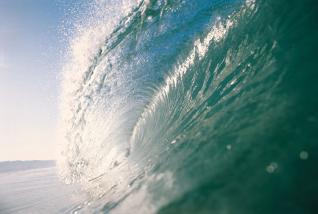Hydro, Wave, and Tidal Power Market Outlook Bright as Conventional Energy Sources Dwindle, Finds Frost & Sullivan
By Pangea Hydro, Wave, and Tidal Power Market
Outlook Bright as Conventional Energy Sources Dwindle
Hydro, Wave, and Tidal Power Market
Outlook Bright as Conventional Energy Sources Dwindle
Prospects for the hydro, wave, and tidal power market look upbeat as countries are investing in renewable energy sources to augment energy security.
MOUNTAIN VIEW, Calif. PRNewswire [WorldofRenewables.com]
It is estimated that the worldwide wave resources is 6,000 TWh/year, twice as much as global nuclear production and 700 TWh/year for tidal power. In other words, the market potential for the wave industry is about $1 trillion worldwide.
New analysis from Frost & Sullivan (http://www.technicalinsights.frost.com/), Hydro, Wave, and Tidal Power--Market Penetration and Roadmapping, finds that ocean (wave and tidal) technology is much more reliable and predictable than other kinds of renewable energies, such as wind or solar. Coupled with vast worldwide resources (2,000 TWh to 4,000 TWh yearly), ocean energy may be the key to answer the world's escalating energy needs.
If you are interested in a virtual brochure for this study, please send an e-mail to Sarah Saatzer, Corporate Communications, at sarah.saatzer@frost.com, with your full name, company name, job title, telephone number, company e-mail address, company website, city, state and country.
"It is projected that commercialization of wave and tidal energy will take place in the next 5-10 years as the technology evolves and production costs decline," notes Technical Insights Research Associate Chin Wai Loon. "Wave and tidal energy are expected to be deployed on a commercial scale due to its large promising resource and high market potential; it is crucial for technology developers to push through into the commercialization phase."
The future of wave and tidal energy depends heavily on financial funding from public, private, and government entities. Deployment of wave and tidal technology will not be easily achievable due to large initial installation cost. The United Kingdom has provided 8 million pounds Sterling for the European Marine Energy Research Centre (EMEC). This research centre will serve as a testing facility for technology developers to create their devices.
In another example, the UK Government has set up 22 million pounds Sterling funding to offset the large capital cost during the installation stage. Marine Current Turbines is another instance, raising sufficient funding to commercialize its 5-MW SeaGen technology. According to Alvin Smith, CEO of Dartmouth Wave Energy Ltd, the current cost for wave energy is estimated to be 2 million pounds Sterling per MW.
Apart from this, the policies and regulations set by the government and the lack of awareness on the potential of wave and tidal resources are stalling market momentum. The extremely harsh weather conditions of the ocean require the technology to be very robust. Pelamis Wave Power has halted its 2.5 MW wave farm in Portugal indefinitely. The reason cited for this is water leakage, which has severely affected their buoyancy device. Apart from this, the company is short on funds due to the recent economic recession.
"To ensure productive outcomes in this space, participants must accelerate their R&D efforts, conduct more sea trials, and reduce overall material usage," says Chin. "Participants must secure more funding from public, private and government sectors by developing prototypes for demonstrations or trial purposes."
By securing ample financial assistance, large-scale devices can be developed to generate more electricity (MW range) instead of prototype scale (kW range). Case in point, Pelamis Wave Power has managed to secure 4.8 million pounds Sterling funding from the UK Government's Marine Renewable Proving Fund (MRPF).
Technology developers could collaborate with each other to accelerate the commercialization phase, while reducing the overall cost. Joint ventures between companies and governments will serve to boost future development in marine renewable energies. Seabased AB, one of the key participants in the wave industry, has collaborated with Fortum Kellaniem to develop the largest wave farm in Sweden, capable of generating 10 MW capacity. Collaborations will not only ratchet down costs, but also help to compete with other renewable technologies, such as solar, hydro, and wind.
Hydro, Wave, and Tidal Power--Market Penetration and Roadmapping, a part of the Technical Insights subscription, provides an in-depth analysis of market drivers and restraints, industry structure, and competitive environment besides dealing with the challenges and issues faced by market participants. Further, this research service includes detailed technology analysis and industry trends evaluated following extensive interviews with market participants.
Technical Insights is an international technology analysis business that produces a variety of technical news alerts, newsletters, and research services.
About Frost & Sullivan
Frost & Sullivan, the Growth Partnership Company, enables clients to accelerate growth and achieve best-in-class positions in growth, innovation and leadership. The company's Growth Partnership Service provides the CEO and the CEO's Growth Team with disciplined research and best-practice models to drive the generation, evaluation, and implementation of powerful growth strategies. Frost & Sullivan leverages over 45 years of experience in partnering with Global 1000 companies, emerging businesses and the investment community from 40 offices on six continents. To join our Growth Partnership, please visit http://www.frost.com/.
Contact: Sarah Saatzer Corporate Communications - North America P: 210.477.8427 E: sarah.saatzer@frost.com http://www.frost.com/ http://www.technicalinsights.frost.com/
Source: Frost & Sullivan
 To subscribe or visit go to:
http://www.renewableenergyaccess.com
To subscribe or visit go to:
http://www.renewableenergyaccess.com